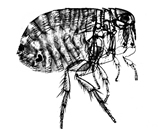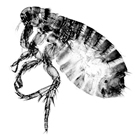Flea


Flea any insect of the order Siphonaptera. A flea is a small (1-8 mm) wingless insect with a body that is greatly flattened from side by side. This unique character of the flea readily separates it from other insects. Adults are generally brownish in colour and have numerous backward-projecting spines and bristles. Their legs are long and well-adapted for jumping. The mouth parts are of the sucking type. Eyes may be present or absent. Adults live ectoparasitically on birds and mammals, and feed on the blood of their vertebrate hosts. There are about 2,500 species of fleas worldwide belonging to 239 genera, but only a dozen species have been recorded in Bangladesh.
Fleas are found throughout the world, but many genera and species have a more restricted distribution. For example, the genus Xenopsylla, which contains important vectors of plague, is confined to the tropics including Bangladesh and the warmer parts of some temperate countries.
Medically, the most important flea are the species of Xenopsylla, such as X. cheopis, a vector of plague (Yersinia pestis), and flea-born endemic typhus (Rickettsia typhi). Some fleas, such as Ctenocephalides, are intermediate hosts of cestodes. Fleas may also transmit tularemia and brucellosis. The jigger flea (Tunga penetrans) burrows into the feet of people.
Certain species of fleas cause annoyance by their bites leading to considerable discomfort and irritation. There are three common fleas in Bangladesh which cause this nuisance, such as the cat flea (Ctenocephalides felis), the dog flea (C. canis), and the human flea (Pulex irritans). There is evidence that children under 10 years generally experience greater discomfort due to flea bites than older people.
Flea-borne plagues have not been recorded in Bangladesh in recent years. In 1994, however, there was an outbreak in India. At that time, precautionary measures were adopted in Bangladesh and no plague case was detected. [Humayun Reza Khan]
See also plague.
